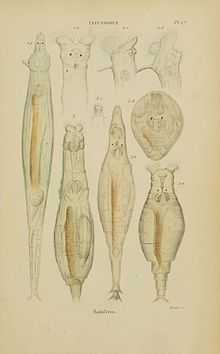Félix Dujardin
| Félix Dujardin | |
|---|---|
| Born | April 5, 1802 |
| Died | April 8, 1860 |
| Nationality | French |
| Fields | Biology |
| Known for | protozoans helminths |

In 1840 he was appointed professor of geology and mineralogy at the University of Toulouse, and during the following year was a professor of zoology and botany at Rennes. Later in his career he became a member of the French Académie des sciences. In regards to his educational background, Dujardin was largely self-taught.
Dujardin is largely known for his work with microscopic animal life, and in 1834 proposed that a new group of one-celled organisms be called "Rhizopoda"; meaning "root-foot". The name was later changed to "Protozoa". He refuted naturalist Christian Gottfried Ehrenberg's concept that microscopic organisms are "complete organisms" similar to higher animals. In addition to his studies of microscopic life, he did extensive research of invertebrate groups that included echinoderms, helminths and cnidarians.
In Foraminifera, he noticed an apparently formless life substance that he named "sarcode", which was later renamed protoplasm by Hugo von Mohl (1805–1872). In 1850[1] he was the first to describe the mushroom bodies,[2] key structures in the insects' nervous system.
Bibliography

- Dujardin F. 1837. Mémoire sur les couches du sol en Touraine et descriptions des coquilles de la craie des faluns.
- Dujardin F. 1841. Histoire naturelle des zoophytes. Infusoires, comprenant la physiologie et la classification de ces animaux, et la manière de les étudier à l'aide du microscope.
- Dujardin F. 1842. Nouveau manuel de l'observateur au microscope.
- Dujardin F. 1845. Histoire naturelle des helminthes ou vers intestinaux. xvi, 654+15 pp. + Plates.
The standard author abbreviation Dujard is applied to species he described.
References
Huard, P; Theodorides, J (1959). "[5 Unrecognized parasitologists.]". Biologie médicale (Apr 1959) 48 (Special No): i–xci. PMID 13651265
External sources
|